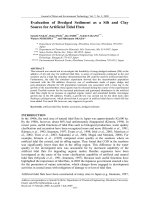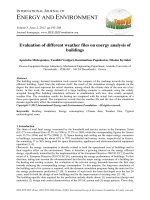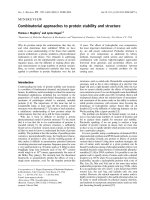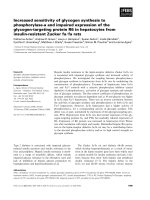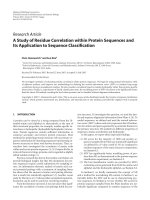Evaluation of different approaches to protein engineering and modulation
Bạn đang xem bản rút gọn của tài liệu. Xem và tải ngay bản đầy đủ của tài liệu tại đây (1.65 MB, 125 trang )
EVALUATION OF DIFFERENT APPROACHES TO
PROTEIN ENGINEERING AND MODULATION
APARNA GIRISH
(M.Sc. (Hons), BITS)
A THESIS SUBMITTED
FOR THE DEGREE OF MASTER OF SCIENCE
DEPARTMENT OF BIOLOGICAL SCIENCES
NATIONAL UNIVERSITY OF SINGAPORE
2006
ACKNOWLEDGMENTS
My two and half year research in science has been an eye opening experience. Before
I went into research, science had always been awe inspiring from far, from the text
books. My masters has taught me that behind the awe inspiring discoveries lies a lot a
hard work from large teams of dedicated and zealous scientists. Putting theory into
practice has certainly been challenging. Trouble shooting becomes a way of life in the
lab, it brings forth opportunities to learn more. I’m glad that the journey through
science has been a rewarding and a great learning experience for me and all that
would not have been possible but for a bunch of people whom I owe this
acknowledgement to. I would like to thank my supervisor, Prof. Yao Shao Qin, for his
ideas, for constantly trying to bring forth the best in me, for never giving up, for the
motivation and for the guidance throughout my projects. I thank all my lab mates for
their constant support and valuable suggestions. I would also like to thank the
graduate committee of the Department of Biological sciences, for having given me
this opportunity to learn and do science in NUS. Lastly but certainly not the least, I
thank mother nature, for being so diverse, intricate, complex and beautiful, so that
humans in their life time on earth may never be short of discovering and experiencing
the true joy that only science can bring.
i
TABLE OF CONTENTS
Acknowledgements
i
Table of contents
ii
Summary
vii
List of publications
ix
List of tables
x
List of figures
xi
List of abbreviations
xiii
1. Introduction
1.1
1.2
1
Protein engineering
1
1.1.1
Rational design and protein evolution to create
novel functions or improve existing functions.
1
1.1.2
Protein engineering: introducing artificial
functionalities using enzyme mediated approaches
2
1.1.3
The three different approaches to protein engineering
and modulation that were evaluated in this report
3
Inteins
1.2.1
1.3
4
Mechanism of protein splicing
5
1.2.2 Engineered inteins in biotechnological
applications
5
1.2.3 The intein based method to tag
proteins site-specifically
7
Phage display
8
1.3.1 Applications of phage display
11
1.3.2
Enzyme evolution on phage
14
1.3.2.1 Developing a strategy to evolve
SrtA on T7 phage
14
ii
1.3.3
2.
Affinity selection of binders against
3CL protease mutant from SARS
19
Materials and methods
22
2.1
Making chemically competent
bacteria for transformation
22
2.2
Transformation of plasmids/ligated vectors
into chemically competent cells
22
2.3
Transformation of yeast cells
23
2.4
PCR
23
2.5
Cloning
24
2.5.1 TA cloning
24
2.5.2
Gateway cloning
24
2.5.3
RE-based cloning into conventional
plasmids and large bacteriophage genomes
26
2.6
Sequencing of genes
28
2.7
Site directed mutagenesis of genes
28
2.8
Expression of different fusion proteins
from different vectors and hosts.
30
2.9
Western blot of proteins
32
2.10
Affinity chromatography of proteins
33
2.10.1 Ni-NTA column
33
2.10.2 GSH column
34
2.10.3 Chitin column
35
2.11
Production of N-terminal cysteine proteins
35
2.12
Spotting of N-terminal cysteine
proteins on thioester slides
36
2.13
In vitro biotinylation of proteins
37
2.14
Spotting biotinylated proteins onto avidin slides
37
iii
2.15
2.16
Enzyme activity assays
38
2.15.1 Testing activity of SrtA
38
2.15.2 In vitro self-ligation assay
39
2.15.3 Self-ligation assay on the phage
39
General phage methods
40
2.16.1 Packaging of T7 phage DNA
40
2.16.2 Amplification of phages
40
2.16.3 PEG precipitation of phages
41
2.16.4 Storage, Serial dilution and titering of phages
41
2.16.5 Plaque lift
42
2.16.6 Sequencing phage
43
2.16.6.1
M13
43
2.16.6.2
T7
43
2.17.7 Phage enrichment methods
3.
44
2.17.7.1
Affinity based enrichment
of C-SrtA-T7
44
2.17.7.2
Activity based enrichment
of C-SrtA-T7
44
2.17.7.3
Bio-panning against SA
and 3CL mutant
45
2.17.7.4
Binding assay
46
Results and discussion
47
3A
The intein mediated approach to
site-specifically label proteins
48
3A.1
The intein based method to
produce N-terminal cysteine proteins
48
3A.1.1 Expression of N-terminal cysteine
-containing proteins from bacteria.
49
iv
3A.2
3B
3C
3A.1.2 Spotting N-terminal cysteinecontaining EGFP onto thioester slides
49
The intein mediated method to site
-specifically label proteins derived from yeast
50
3A.2.1 Expression levels and the in vivo cleavage
pattern of the Intein-fusion proteins
in yeast
52
3A.2.2 On-column cleavage and generation
of biotinylated proteins
54
3A.2.3 Detection on the microarray
56
Designing a selection scheme to evolve SrtA on phage
58
3B.1
The N-terminus extension scheme
58
3B.2
The C-terminus extension scheme
60
3B.3
Activity of SrtA with N-and C-terminal extensions
60
3B.4
Self-ligation assay of N/C-SrtA
62
3B.5
Display of N/C-SrtA on phages
62
3B.6
Activity assay of the SrtA on phage
64
3B.7
Enrichment of SrtA-phages from a pool of bare phages
67
3B.7.1 Affinity based enrichment
67
3B.7.2 Activity based enrichment
67
Detection of binders of 3CL protease from a phage library
71
3C.1
Biopanning of a model protein Streptavidin
71
3C.2
Binding assay to detect the strongest of binders
72
3C.3
Expression and mutation of the 3CL protease
74
3C.4
Bio-panning against the 3CL protease mutant
74
4.
Conclusions
79
5.
References
82
Appendix A
95
v
Appendix B
102
vi
SUMMARY
Proteins are important molecular machines within cells. Ability to modulate and
engineer proteins serves as important tools to understand their structure and function.
Different methods are available to engineer proteins. These include protein evolution
methods and enzyme-based methods to introduce artificial functionalities. Protein
evolution can give rise to useful proteins that can fulfill biotechnological and
industrial applications. Protein engineering methods which add on small molecule
tags site-specifically have many applications including bio-imaging, where by
specifically adding a fluorescent tag onto a protein, one can study protein dynamics,
localization, cell movement and cell growth. Site-specific modification of proteins has
also found use in the field of microarrays, where adding on tags such as biotin to a
protein allow it to be specifically immobilized onto an avidin-coated surface.
Different approaches to protein engineering and modulation using the phage display
method and the intein splicing strategy were evaluated in this report.
A strategy for the immobilization of proteins site-specifically via the N-terminus onto
the microarray was developed. The chosen model proteins were cloned into a vector
system that facilitates the expression of the protein with an N-terminal intein fusion.
An extra cysteine residue was introduced at the junction of the intein and protein
fusion. Upon expression of the intein-protein fusion, intein splices out leaving the
protein with an N-terminal cysteine. The proteins thus produced can then be applied
to thioester-functionalized slides for uniform orientation. As a complementary
approach, a system to biotinylate the C-terminus of proteins derived from yeast was
set up. The expression levels and the splicing patterns of three different intein fusion
vii
constructs were studied. Optimal conditions for biotinylation of a model protein were
achieved and the immobilization efficiency onto to an avidin microarray was
evaluated.
As an approach to protein engineering for the enzyme Sortase, a selection scheme for
the evolution of increased activity of Sortase on phage has been devised. Sortase is a
transpeptidase, which catalyzes the transfer of N-terminal glycine peptides to the
sorting motif LPETG found in proteins. Studies of Sortase revealed that it could be
used for attaching small molecule tags to proteins and that Sortase is not a very robust
enzyme in vitro. A selection scheme has been devised to select for mutants of Sortase
with improved activity by displaying them on the surface of the phage. Using this
selection method and a suitable screening system, Sortase may be evolved into a more
active enzyme.
Phage display library displaying random peptides was scanned for good binders to the
active site mutant of SARS main protease 3CL. Using the affinity selection method in
phage display, multiple rounds of selection were carried out. A binding assay at the
end selection revealed the existence of weak binders to the protease. Several
candidate peptides that bound the mutant protease with low affinity were sequenced
and identified.
viii
LIST OF PUBLICATIONS
1. Girish, A., Chen, G.Y.J., and Yao,S.Q., (2006) “Protein engineering for
surface attachment”in Microarrays:pathways to drug discoverey. (P.predki,
ed.) CRC press.
2. Girish, A., Sun, H., Yeo, D.S.Y., Chen, G.Y.J., Chua, T.-K. and Yao, S.Q.
(2005), Site-specific immobilization of proteins in a microarray using inteinmediated protein splicing. Bioorg. Med. Chem. Lett.,15, 2447-2451.
3. Zhu, Q., Girish, A., Chattopadhaya, S., and Yao, S.Q., (2004), Developing
novel activity-based fluorescent probes that target different classes of
proteases. Chem. Commun., 1512-1513.
ix
LIST OF TABLES
1. Results from the binding assay from biopanning against SA
73
2. Sequencing results of the peptides from
biopanning against SA
75
3. Sequencing results of the peptides from
biopanning against Streptavidin
76
4. Sequencing results of the peptides from
biopanning against 3CL mutant
78
x
LIST OF FIGURES
1. Mechanism of protein splicing
6
2. The intein-mediated strategy to biotinylate
proteins at the C-terminus
10
3. General scheme for affinity based enrichment
of peptides libraries on phage
13
4. Hydrolysis and transpeptidation activity of Sortase
16
5. Evolution of SrtA on phage
8
6. Self ligation of G5-BIOTIN substrates onto C-SrtA
16
7. Self ligation of biotin-LPETG substrate onto N-SrtA
20
8. Self ligation of G2-TMR substrates onto
C-SrtA displayed on the T7 phage
20
9. The BP cloning reaction
25
10. The LR cloning reaction
25
11. RE-based cloning of SrtA into the T7 phage genome
29
12. Overview of site-directed mutagenesis methods
31
13. Results from N-terminal immobilization strategy
51
14. Native fluorescence of EGFP-Intein fusion
from yeast after cell lysis and clarification
53
15. Expression timeline of the three EGFP-Intein-CBD
fusions in the yeast host detected using anti-CBD western blot
53
16. In vivo cleavage pattern of the three EGFP-Intein fusions
in yeast crude cell lysates as detected using anti-CBD western blot
55
17. Purification of EGFP-Intein 3 fusion from yeast small scale cultures
55
18. Effect of different concentrations of cys-Biotin
on the biotinylation efficiency of EGFP purified from different hosts
55
19. Purification of SrtA and different versions of SrtA
63
20. Activity assay of SrtA, N-SrtA and C-SrtA as
detected by in-gel fluorescence scanning
63
xi
21. Transpeptidation of SrtA and C-SrtA as measured
using quenched fluorescent substrates
65
22. Hydrolytic activity of SrtA and C-SrtA as
measured using quenched fluorescent substrates
65
23. Self-ligation assay of N-SrtA and C-SrtA as
detected by anti-Biotin western blot
66
24. Plaque lift
66
25. Expression levels and activity assay of C-SrtA
on the T7 phage as detected by anti-Biotin western blot
66
26. Activity assay of C-SrtA on T7 phage
69
27. Self ligation assay of C-SrtA on T7 phage
69
28. Affinity enrichment of C-SrtA-T7-phage
69
29. Activity based enrichment of C-SrtA-T7-phage
70
30. Expression levels of 3CL protease and 3CL protease mutant
75
xii
LIST OF ABBREVIATIONS
A
Alanine
Amp
Ampicillin
BPB
Bromo Phenol Blue
C
Cysteine
CBD
Chitin Binding Domain
Cys-Biotin
Cysteine – Biotin
DABCYL
α-(t-BOC)- -(4-DimethylAminophenylazoBenzoyl)-Llysine ( -(t-BOC)- -dabcyl-L-lysine)
DBS
Department of biological sciences
Dil
Dilution
dNTP
deoxy Nucleotide Tri Phosphate
DNA
deoxy Nucleic Acid
DTT
Di Thio Thrietol
E
Glutamic acid
EDTA
Ethylene Diamine Tetra Acetic acid
EGFP
Enhanced Green Fluorescent Protein
ELISA
Enzyme Linked Immuno Sorbent Assay
F
Phenyl alanine
FITC
Fluorescein Iso Thio Cyanate
Fwd
Forward
Gly (G)
Glycine
GSH
Glutathione
GST
Glutathione S Transferase
xiii
His (H)
Histidine
I
Isoleucine
IPTG
IsoPropyl-beta-D-Thio-Galacto-pyranoside
kDa
kilo Daltons
L
Leucine
LB
Luria Bertani
Min
Minute(s)
MESNA
Methyl Ethyl Sulfonic Acid
Ni-NTA
Nickel- Nitrilo Tri Acetic acid
NUS
National university of Singapore
NEB
New England Biolabs
O/N
Over Night (12 hours)
OD
Optical Density
ORF
Open Reading Frame
P
Proline
PBST
Phosphate Buffered Saline with Tween-20
PCR
Polymerase Chain Reaction
pfu
Plaque Forming Units
PEG
Poly Ethylene Glycol
PVDF
Poly Vinidiliene Di Fluoride
PAGE
Polyacryl Amide Gel Electrophoresis
Q
Asparagine
RT
Room Temperature
RE
Restriction Enzyme
Rev
Reverse
xiv
RNA
Ribo Nucleic Acid
S
Serine
SARS
Severe Acute Respiratory Syndrome
SrtA
Sortase A
Sec
Seconds
SDS
Sodium Dodecyl Sulphate
SA
Streptavidin
SH3
Src like Homology
TMR
tetra methyl rhodamine
T
Threonine
U
Units
V
Valine
W
Tryptophan
X-Gal
5-bromo-4-chloro-3-indolyl- beta -D-galactopyranoside
Y
Tyrosine
2XYT
Rich growth media, see appendix for composition
6XHIS
Poly Histidine (6 repeats of Histidine)
2-ME
2-Mercapto-Ethanol
3CL
3C like
xv
1.
INTRODUCTION
1.1
Protein engineering
Proteins are the most important work horses in the cells; they serve myriad functions
and are also important structural determinants within cells. Ability to modulate and
engineer proteins serves as important tools to understand their structure and function
[1], it can also give rise to useful proteins that can fulfill biotechnological and
industrial applications [2]. The terms “Protein engineering” and “modulation” are
used in the following context throughout the thesis and are defined as, “Processes of
modifying the structure of proteins or introducing unnatural functionalities to create
tailor-made proteins serving useful applications”. Several methods that exist to
modify and engineer proteins can be broadly grouped into 2 different categories. (a)
Rational design and Protein evolution methods to create novel functions or improve
existing functions. (b) Enzyme-based methods to introduce unnatural but useful
functionalities.
1.1.1
Rational design and protein evolution to create novel functions or
improve existing functions.
Proteins as such are pretty robust inside cells, but their performance is typically
hampered outside natural environments and several proteins fail to behave well in
industrial applications [2, 3]. Traditionally the approach to study and design proteins
with improved or novel function has been through the genetic method of site directed
mutagenesis [1]. It requires detailed knowledge of protein structure and has the
limitation in that substitution of desired amino acids can be done only with their
natural amino counterparts. Proteins are complex entities and more often it is very
difficult to predict exactly what structural changes will give rise to the desired
1
function. These limitations can be overcome by taking the proteins through the
process of protein evolution [4], which mimics the natural process of evolution in the
laboratory test tube. The key points of the protein evolution methods are mutagenesis
and selection of the fittest. A repertoire of random mutants of a desired gene is created
using genetic methods like error prone PCR or gene shuffling and linked to a suitable
genetic coding system like phage display. The pool of mutants is then passed through
a selection/screening assay that select for the mutants with the desired function. The
genetic pool is culled periodically of undesirable mutations through a negative
selection if possible. The whole process of mutagenesis and selection/screen may then
be repeated until the proteins with desirable functions evolve [5]. Thus it is in essence
bringing natural evolution to the test tube.
1.1.2
Protein engineering : introducing artificial functionalities using enzymemediated approaches
Several enzymes that can site specifically add on small molecule functionalities have
been exploited to modify proteins. Some of them include Inteins [6-11], Biotin ligases
[12], Sortase [13], Sfp phosphopantetheinyl transferase [14] and Amino Acyl - tRNAtransferases [15-19]. Protein engineering methods which add on small molecule tags
site specifically have many applications. One such example is in the field of bioimaging, where by specifically adding on fluorescent tags onto proteins, one can study
protein dynamics, localization, cell movement and cell growth [20, 21]. Site-specific
modification of proteins has also found use in the field of microarrays, where adding
on tags like biotin to a protein allows it to be specifically immobilized onto an avidincoated surface [10, 11, 22].
2
1.1.3
The three different approaches to protein engineering and modulation
that were evaluated in this report
In this report, three different approaches to protein engineering and modulation were
evaluated. As one of the approaches to protein engineering, a strategy for the
immobilization of proteins site-specifically via the N-terminus onto the microarray
was developed. The chosen model proteins were cloned into a vector system that
facilitates the expression of the protein with an N-terminal intein fusion. An extra
cysteine residue was introduced at the junction of the intein and protein fusion. Upon
expression of the intein-protein fusion, intein splices out, leaving the protein with an
N-terminal cysteine. The proteins thus produced can then be applied onto thioesterfunctionalized slides for uniform orientation. As a complementary approach, a system
to biotinylate the C-termini of proteins derived from yeast was set up. The expression
levels and the splicing patterns of three different intein fusion constructs were studied.
Optimal condition for biotinylation of a model protein was achieved and the
immobilization efficiency onto to an avidin microarray was evaluated. Once the
system was established it was foreseen that important enzymes present in the yeast
namely the kinases, phosphatases and proteases could be immobilized using this
versatile method to generate an enzyme array. The enzymes could then be studied in a
high throughput fashion using some of the available activity-based fluorescent probes
in our lab [23-26].
As an approach to protein engineering, a selection scheme for the evolution of
increased activity of SrtA on phage has been devised. SrtA is a transpeptidase, which
catalyzes the transfer of N-terminal glycine peptides to the sorting motif LPETG
found in proteins. Studies of SrtA revealed that it could be used for attaching small
3
molecule tags to proteins and that SrtA is not very robust in vitro. A selection scheme
has been devised to select for mutants of SrtA with improved activity by displaying
them on the surface of the phage. Using this selection method and a suitable screening
system, SrtA could be evolved into a more active enzyme.
Phage display library displaying random peptides was scanned for good binders to the
active site mutant of SARS main protease 3CL. Using the affinity selection method in
phage display, multiple rounds of selection were carried out. A binding assay at the
end of multiple rounds of selection revealed the existence of weak binders to the
protease. Several candidate peptides that bound the mutant protease with low affinity
were sequenced and identified. The subsequent sections of this chapter will introduce
some of the relevant topics in more detail.
1.2
Inteins
Inteins are naturally occurring in frame protein fusions that can self splice out,
ligating together the extein sequences of the gene in which they occur. They are very
similar to the group I self splicing introns which splice at the RNA level [27]. Inteins
since their first description in yeast Saccharomyces cerevisiae [28, 29], have now
been identified in all three kingdoms of life, as well as in bacteriophages. Many of the
inteins like the group I introns are mobile at the genetic level because they code for
homing endonucleases [27]. Upto 70% of the inteins identified are found in genes that
are related to DNA metabolism including DNA polymerases, helicases and gyrases
[27], which often are vital genes to the organism [30]. Although inteins have been
denoted as selfish genes, because no known function exists for many of them, some
experiments have suggested that they might hold regulatory roles in cells, and that
4
ancestral inteins might have had some function but they were lost during evolution
[27, 30].
1.2.1
Mechanism of protein splicing
The mechanism of protein splicing has been well studied by many groups [31-33].
There are several key residues involved in protein splicing. The first amino acid of Nintein (see Figure 1) is invariably a cysteine or a serine residue. The thiol or the
hydroxyl side chains of these amino acids undergo an acyl shift at the N-terminal
splice junction. The first residue of C-extein is invariably a cysteine or threonine or
serine. The side chains of these are equipped to attack the electrophilic N-terminal
splice junction, resulting in a branched intermediate. An asparagine residue precedes
the C-terminal splice junction, and helps in resolving the intermediate through
cyclization and succinimide formation. Eventually an S-N acyl shift releases the
spliced product.
1.2.2 Engineered inteins in biotechnological applications
Intein splicing does not require cofactors and the process of splicing is very efficient
[34]. The novelty of inteins, ever since their discovery, has been exploited for a
variety of biotechnological applications, ranging from synthesizing toxic proteins (by
expressing them in two parts in the cell and ligating them externally using the inteinmediated method to give the native peptide bond [35]), cyclization of proteins and
peptides [36], attaching novel functionalities to proteins site specifically [6-11],
generation of novel protein combinations [37] and intein mediated genetic switches
5
Figure 1: The steps involved in the self splicing of inteins, see text for details.
(Splicing mechanism taken from />
6
[38, 39]. NEB has commercialized vectors that enable the cloning of desired genes
with an intein either at the N/C-terminus and a CBD tag. Upon expression and affinity
column purification, the protein of interest can be cleaved off by inducing intein
cleavage under some specified conditions [31]. The inteins that can splice out
conditionally were engineered from the native counterparts through a combination of
both rational engineering and directed evolution approaches [40-42]. These inteins
were designed such that they splice out only from either N/C-terminus, and they were
pH or thiol agent inducible [40-42].
1.2.3 The intein based method to tag proteins site-specifically
Protein microarray is emerging as a powerful tool in the high throughput analysis of
protein abundance and function [43-45]. One of the key concerns in the fabrication of
functional protein microarrays is the method of immobilization, which to some extent
determines whether or not a protein retains its function [46]. There are two obvious
choices, either random immobilization or methods that allow site-specific uniform
orientation. Both of these methods have been used to develop protein microarrays
[47]. In this report a strategy for the immobilization of proteins onto a microarray site
specifically via the N-terminus was developed. For the N-terminal immobilization,
the chosen model proteins were cloned onto a vector system that facilitates the
expression of the protein with an N-terminal intein fusion. An extra cysteine residue
was introduced at the junction of the intein and protein fusion. Upon expression of the
intein-protein fusion, intein splices out, leaving the protein with an N-terminal
cysteine [6]. N-terminal cysteine containing EGFP was produced in this manner and
successfully immobilized onto thioester glass surface. Also as a complementary
approach to the N-terminal immobilization, immobilizing proteins expressed from a
7
yeast host, via a C-terminus biotin moiety onto avidin-functionalized microarrays was
considered. Three different inteins available from NEB, were fused individually to the
C-terminus of the EGFP, and expressed in a suitable yeast expression system. The
expression levels and the in vivo cleavage pattern of the three inteins were analyzed.
One of the three inteins, the Sce VMA Intein was found to express better than the
other fusions and the in vivo cleavage of the fusion was minimal. Hence the Sce VMA
Intein fusion was chosen for further studies. Fusion to intein at the C-terminus allows
the production of thioester functionality at the C-terminus, which in turn can react
with the sulfhydryl moiety of the cysteine in cysteine-biotin, to give a C-terminal
biotinylated protein via a native peptide bond. Using this, a model protein EGFP was
biotinylated and the immobilization efficiency onto to an avidin microarray was
evaluated. Once the system was established it was foreseen that important enzymes
present in the yeast, namely the kinases, phosphatases and proteases, could be
immobilized in a high-throughput fashion using this method. Then they could be
studied in a parallel fashion using the available activity based fluorescent probes in
our lab [23-26].
1.3
Phage display
Bacteriophages are virus that feed on bacteria. They have a simple structure with their
nucleic acid genome surrounded by a coat of proteins [50]. There are two kinds of
bacteriophages, the lytic ones and the nonlytic ones [51]. For many years
bacteriophage genomes have traditionally been used as vehicles of gene transfer to
bacteria [51, 52]. The concept of phage display was introduced by George P Smith,
who came up with a method to display foreign peptides on the surface of the
bacteriophage M13, through a fusion to its coat protein Gene III [53]. Product of Gene
8
III resides on the tip of the filamentous bacteriophage and is involved in infection of
the host bacterium. He found that small peptides fused to the N-terminus of the Gene
III can be displayed on the phage tip without interference to its infective capacity
[53]. He called his method phage display and demonstrated its first application in
mapping epitopes of antigens [54]. Ever since, peptides and proteins have been
successfully displayed on phage and a collection of phage display vectors are now
commercially available [52].
Typically the protein/peptide of interest is cloned into either bacteriophage
genome/phagemids using traditional cloning methods. The most commonly used
phage is the M13 phage. There are two different genes that are typically used for the
display of peptides and proteins on M13. One is the gene III, this is present in up to 5
copies on the tip of the virion. Gene VIII is another available display protein system,
it is present in up to 2700 copies per virion. Due to steric limits only small peptides
are tolerated in the latter system. The Gene III system can tolerate proteins up to
100kDa [3], but the number of copies displayed on each virion should be limited as
the protein gets larger [55]. This is done by cloning the protein of interest into a
phagemid rather than into the phage genome itself, and then rescuing the phagemid (a
phagemid is a plasmid with phage origin of replication; when F+ cells, harboring such
phagemids are infected by a helper phage, the phagemid gets replicated from the
phage origin and packaged into the phage heads preferentially over the helper phage
genome) using helper phages (phages whose genomes contain impaired origin of
replications). When using the phagemid method to display proteins, depending on the
size of the protein and how well it is tolerated on the phage, the number of copies of
the
displayed
protein
can
vary
from
0-5
per
phage.
9
